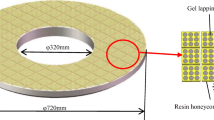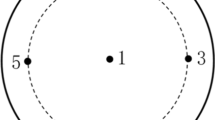Abstract
To enhance the lap** effects of sapphire wafers, two vitrified bonded fixed-abrasive lap** plates with different mechanical properties were developed and used to lap sapphire wafers to evaluate the effects of lap** time and dressing cycle on the lap** process effect and the stability of the lap** plates. The results indicate that the lap** material removal rate (MRR) and surface roughness (Ra) of the workpiece decrease with increasing lap** time; the higher the hardness of the lap** plate, the larger the MRR and Ra. There are differences in the primary wear forms between the two types of plates, with the high-hardness plate being mainly abrasive wear and abrasive breakage, while the low-hardness plate being mainly abrasive peeling off and abrasive wear. The two plates have the same trend in material removal for sapphire wafers - increasing the lap** time, the MRR is found to be gradually decreased and plateaued after 30 min, which is only about 20% of that of the initial lap** time, resulting in the plates needing to be dressed. After dressing the lap** plates, the plate processing performance returns to its initial state; the MRR deviation is less than 10% within the same period of use after several dressings.

















Similar content being viewed by others
References
Gagliardi JJ, Kim D, Sokol JJ, Zazzeraa LA, Romeroa VD, Atkinsonb MR, Nabulsi F, Zhang H (2013) A case for 2-body material removal in prime LED sapphire substrate lap** and polishing. J Manuf Process 15:348–354. https://doi.org/10.1016/j.jmapro.2012.11.005
Li ZC, Pei ZJ, Funkenbusch PD (2011) Machining processes for sapphire wafers: a literature review. P I Mech Eng B-J Eng 225:975–989. https://doi.org/10.1177/2041297510393667
Kim MH, Manivannan R, Moon DJ, ** using a fixed abrasive pad for sapphire substrate. Wear 302(1–2):1340–1344. https://doi.org/10.1016/j.wear.2012.11.075
Chen JP, Zhu YW, Wang XB, Peng YN, Yao JG, Ming S (2019) Relationship between mechanical properties and processing performance of agglomerated diamond abrasive compared with single diamond abrasive. Diam Relat Mater 100:107595. https://doi.org/10.1016/j.diamond.2019.107595
Wang LJ, Hu ZW, Chen Y, Yu YQ, Xu XP (2020) Material removal mechanism of sapphire substrates with four crystal orientations by double-sided planetary grinding. Ceram Int 46:7813–7822. https://doi.org/10.1016/j.ceramint.2019.11.284
Chen JP, Sun T, Su JX, Li J, Zhou P, Peng YN, Zhu YW (2021) A novel agglomerated diamond abrasive with excellent micro-cutting and self-sharpening capabilities in fixed abrasive lap** processes. Wear 464–465:203531. https://doi.org/10.1016/j.wear.2020.203531
Zheng FZ, Zhu YW, Zhu NN, Wang K, Shen Q (2016) Parameter optimization of sapphire with fixed abrasive pad. Diam Abras Eng 36:11–15. https://doi.org/10.13394/j.cnki.jgszz.2016.1.0003
Zheng FZ, Zhu NN, Zhu YW, Li XL, Li J, Zuo DW (2017) Self-conditioning performance of hydrophilic fixed abrasive pad. Int J Adv Manuf Tech 90:2217–2222. https://doi.org/10.1007/s00170-016-9553-9
Dong ZC, Cheng HB (2014) Study on removal mechanism and removal characters for SiC and fused silica by fixed abrasive diamond pellets. Int J Mach Tool Manu 85(5):1–13. https://doi.org/10.1016/j.ijmachtools.2014.04.008
Yin T, Wang ZD, Doi T, Kurokawa S, Tan Z, Ding XK, Lin H (2021) Characteristic of SiC slurry in ultra-precision lap** of sapphire substrates. Int J Precis Eng Man 22:2021–2029. https://doi.org/10.1007/s12541-021-00521-1
Deng JY, Lu JB, Zeng S, **-polishing plate for single-crystal 4H-SiC. Surf Interfaces 29:101646. https://doi.org/10.1016/j.surfin.2021.101646
Deng JY, Lu JB, Zeng S, Yan QS, Pan JS (2021) Processing properties for the Si-face of the 4H-SiC substrates using the magnetically-controlled abrasive solidification orientation-solid-phase Fenton reaction for the fabrication of the lap**-polishing plate. Diam Relat Mater 120:108652. https://doi.org/10.1016/j.diamond.2021.108652
Gao S, Kang RK, Dong ZG, Zhang B, Wang ZG (2016) Surface integrity and removal mechanism in lap** sapphire wafers with novel vitrified bond diamond plates. Mater Manuf Process 32:121–126. https://doi.org/10.1080/10426914.2016.1140194
Wang ZK, Niu FL, Zhu YW, Li J, Wang JB (2019) Comparison of lap** performance between fixed agglomerated diamond pad and fixed single crystal diamond pad. Wear 432–433:202963. https://doi.org/10.1016/j.wear.2019.202963
Wang ZK, Niu FL, Wang ZK, Li J, Sun T, Zhu YW (2021) Friction and wear characteristics of agglomerated diamond abrasives and lap** performance of fixed agglomerated diamond pads. Wear 470–471:203598. https://doi.org/10.1016/j.wear.2020.203598
Zhou ZZ, Wen DH, Zhang KH, Lu CD, Yuan JL (2008) Experimental investigation on the effect of abrasive grain size on the lap** uniformity of sapphire wafer. China Mech Eng 21:2549–2552. https://doi.org/10.3321/j.issn:1004-132X.2008.21.008
Guo L, Zhang X, Chen SB, Hui JZ (2019) An experimental study on the precision abrasive machining process of hard and brittle materials with ultraviolet-resin bond diamond abrasive tools. Materials 12:1–11. https://doi.org/10.3390/ma12010125
Yun JC, Wang BY, Lee ES, Lee CH, Lim YK, Lim DS (2018) Effect of the properties of uniformly patterned micro-diamond pellets on sapphire grinding. J Korean Phys Soc 73(7):871–876. https://doi.org/10.3938/jkps.73.871
Fang CF, Liu C, Zhao ZX, Lin YF, Hu ZW, Xu XP (2018) Study on geometrical patterns of textured fixed-abrasive pads in sapphire lap** based on trajectory analysis. Precis Eng 53:169–178. https://doi.org/10.1016/j.Precisionneng.2018.03.008
Wang WS, Yu YQ, Hu ZW, Fang CF, Xu LuJ, XP, (2020) Removal characteristics of sapphire lap** using composite plates with consciously patterned resinoid-bonded semifixed diamond grits. Curr Comput-Aided Drug Des 10(4):293. https://doi.org/10.3390/cryst10040293
Chen JP, Zhu NN, Niu FL, Peng YN, Su JX, Zhu YW (2020) Influence of agglomerated diamond abrasive wear on sapphire material removal behavior. Diam Relat Mater 108:107965. https://doi.org/10.1016/j.diamond.2020.107965
Kim HM, Park GH, Seo YG, Moon DJ, Cho BJ, Park JG (2015) Comparison between sapphire lap** processes using 2-body and 3-body modes as a function of diamond abrasive size. Wear 332–333:794–799. https://doi.org/10.1016/j.wear.2015.02.029
Funding
The National Natural Science Foundation of China (No. 52175385 and No. U1801259) provided financial support.
Author information
Authors and Affiliations
Corresponding authors
Ethics declarations
The material has not been published in whole or in part elsewhere. The paper is not currently being considered for publication elsewhere. All authors have been personally and actively involved in substantive work leading to the report and will hold themselves jointly and individually responsible for its content. The authors declare that they have no conflict of interest.
Additional information
Publisher's Note
Springer Nature remains neutral with regard to jurisdictional claims in published maps and institutional affiliations.
Rights and permissions
Springer Nature or its licensor (e.g. a society or other partner) holds exclusive rights to this article under a publishing agreement with the author(s) or other rightsholder(s); author self-archiving of the accepted manuscript version of this article is solely governed by the terms of such publishing agreement and applicable law.
Received:
Accepted:
Published:
Issue Date:
DOI: https://doi.org/10.1007/s00170-022-10294-0




